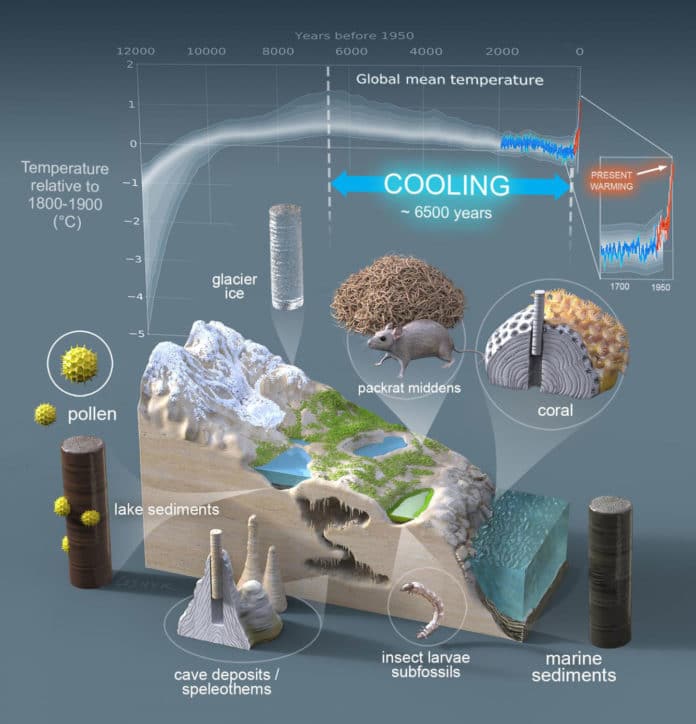During the two millennia before the 20th Century, global mean surface temperature (GMST) cooled at a rate of roughly −0.15 °C per 1000 years.
Not well known, however, is: when did the multi-millennial cooling begin, and has recent global warming exceeded the maximum GMST of the Holocene?
The only previous GMST reconstruction for the Holocene based on multi-proxy data2 showed maximum warmth around 7000 ± 2000 years ago, followed by multi-millennial global cooling.
Now, a new study by Northern Arizona University‘s School of Earth and Sustainability (SES), over the past 150 years, global warming has more than undone the global cooling that occurred over the past six millennia.
The study had suggested that the millennial-scale global cooling began approximately 6,500 years ago when the long-term average global temperature topped out at around 0.7°C warmer than the mid-19th Century.
Four researchers of Northern Arizona University’s School of Earth and Sustainability (SES) led the study, with Regents’ professor Darrell Kaufman as lead author and associate professor Nicholas McKay as co-author, along with assistant research professors Cody Routson and Michael Erb.
For this study, scientists collaborated with scientists from research institutions all over the world to reconstruct the global average temperature over the Holocene Epoch–the period following the Ice Age and beginning about 12,000 years ago.
Regents’ professor Darrell Kaufman as the lead author, said, “Before global warming, there was global cooling. Previous work had shown convincingly that the world naturally and slowly cooled for at least 1,000 years before the middle of the 19th Century when the global average temperature reversed course along with the build-up of greenhouse gases. This study, based on a major new compilation of previously published paleoclimate data, combined with new statistical analyses, shows more confidently than ever that the millennial-scale global cooling began approximately 6,500 years ago.”
Earlier this year, an international group of 93 paleoclimate scientists from 23 countries–also led by Kaufman, McKay, Routson, and Erb–published the most comprehensive set of paleoclimate data ever compiled for the past 12,000 years, compressing 1,319 data records based on samples taken from 679 sites globally.
At each site, scientists analyzed ecological, geochemical, and biophysical evidence from both marine and terrestrial archives, such as lake deposits, marine sediments, peat, and glacier ice, to infer past temperature changes. Countless scientists working around the world over many decades conducted basic research contributing to the global database.
Assistant research professor Michael Erb said, “The rate of cooling that followed the peak warmth was subtle, only around 0.1°C per 1,000 years. This cooling seems to be driven by slow cycles in the Earth’s orbit, which reduced the amount of summer sunlight in the Northern Hemisphere, culminating in the ‘Little Ice Age’ of recent centuries.”
Nicholas McKay, a co-author of the study, who developed some of the statistical approaches to synthesizing data from around the world, notes that individual decades are not resolved in the 12,000-year-long temperature reconstruction, making it difficult to compare it with any recent decade.
“On the other hand, this past decade was likely cooler than what the average temperatures will be for the rest of this Century and beyond, which are very likely to continue to exceed 1°C above pre-industrial temperatures.”
“It’s possible,” Kaufman said, “that the last time the sustained average global temperature was 1°C above the 19th century was before the last Ice Age, back around 125,000 years ago when sea level was around 20 feet higher than today.”
“Investigating the patterns of natural temperature changes over space and time helps us understand and quantify the processes that cause the climate to change, which is important as we prepare for the full range of future climate changes due to both human and natural causes,” said Routson.
Our future climate will largely depend on the influence of human factors, especially the build-up of greenhouse gases. However, the future climate will also be influenced by natural factors, and the natural variability will complicate it within the climate system. Future projections of climate change will be improved by better accounting for both anthropogenic and natural factors,” he said.
The reconstruction of past global temperature is the outgrowth of several NAU research projects aimed at understanding the causes and effects of natural climate variability, work that was funded through more than $1.2 million in grants from the National Science Foundation. The team was recently awarded another $678,000 in grants from the NSF for related work extending through 2023.
Journal Reference:
- Kaufman, D., McKay, N., Routson, C. et al. Holocene global mean surface temperature, a multi-method reconstruction approach. Sci Data 7, 201 (2020). DOI: 10.1038/s41597-020-0530-7
